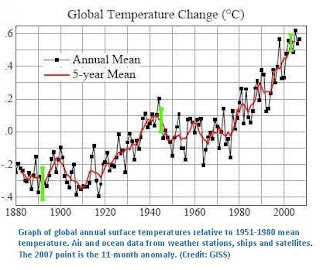2010 has been reported as the warmest year in the history. According to the analysis of NASA’s Goddard Institute for space studies (GISS) in New York, global surface temperature in 2010 was 0.74oC warmer than the average global surface temperature from 1951 to 1980 (which is considered as a standard global temperature for climate change study). Similarly, the temperature recorded is 0.62oC above than 20th century average global temperature. GISS says that the warmest years since record keeping begun in 1880 are 2005 and 2010 (tied) followed by 1998, 2002,2003,2006,2007 and 2009.
The year 1934 was a very hot year in United States, in the third position after 2005/2010 and 1998. Therefore climate change skeptics said that recent hot years are not unusual. However, we cannot ignore the fact that ten consecutive hottest years since 1880 in the global history are after 1998. The analysis done by GISS is based on the weather data from more than 1000 meteorological stations all around the world and satellite observed data for sea surface and arctic region.
 While talking about the Himalayas, warming trend has been recorded much greater than the global average. According to the reports from ICIMOD the temperature increasing rate in Nepal is 0.6oC per decade which is quite higher than that of the global average of 0.74oC (0.074 oC per decade) over last one hundred years. This result is very close to the results obtained from some other individual research.
While talking about the Himalayas, warming trend has been recorded much greater than the global average. According to the reports from ICIMOD the temperature increasing rate in Nepal is 0.6oC per decade which is quite higher than that of the global average of 0.74oC (0.074 oC per decade) over last one hundred years. This result is very close to the results obtained from some other individual research. The global warming has the multidimensional adverse effect in the earth environment and the living beings. Greater uncertainty in the rainfall and the flood in Pakistan last year are some of the recent examples. Similarly, we have been fighting with the winter drought in last couple of years. Several reports have been published in the media about the starvation in 2008/2009 in far and mid western region of Nepal, which is also the impact of climate change. Furthermore, unseasonal and untimely blooming of rhododendron in our forest is also the live example which shows the impact of climate change in our ecology.
As the altitude increased, adverse impact of global warming is also increased. Therefore, the Himalayas is one of the most vulnerable region in the world. The warming has impacted in the glacial ecosystem tremendously. Several researches revealed that about sixty seven percent of glaciers are retreating in the Himalayas and climate change has been identified as the major factor in it. Various researchers claim different altitudes of snow lines (altitude above which there is snow all the time) ranging from 5200 m to 6000 m, but my own research shows that currently it is 5400 m which was 4700 m until late 90’s. The snow melting does not have a single effect; it has significant effects on the late spring and summer runoff in the Nepalese rivers. This will have dramatic adverse effects on biodiversity and habitants for stream biota and livelihood in lower catchment.
The global warming seems inevitable fact/event, and nobody can mitigate or control the warming trend and its adverse effect. Therefore, many countries in the world have already implemented their strategy to adopt in the changing environment rather than mitigation. We also have to go to implement the adaptation strategy without any delay if we want our existence in the world.
While developing the climate change strategies, we have to focus in mitigation of the negative impacts on human societies, reduce their vulnerability in different aspects of human life like agriculture, water resources or other natural resources which have more impact in our socioeconomic aspects. The activities may include the crop translocation or reschedule the crop plantation. Planned and effective uses of water or construction of the big reservoirs in the Himalayas region to store the monsoon water and uses in the rest of the time in the year for multiple purpose. Therefore, it would be better, if the national planning commission keep in mind about the adaptation strategy while developing infrastructures.
Mr. Bhogendra Mishra
Very Nice Artilcle.......................... Nepal Government and other agencies also should be given attention about the Global warming and its impacts in vulnerable local people................
ReplyDeleteIt's very informative. I like the way article represents the facts from an eclectic sources. It would have nice if author had more focused on different strategies used by other developed country to fight with global warming.
ReplyDelete